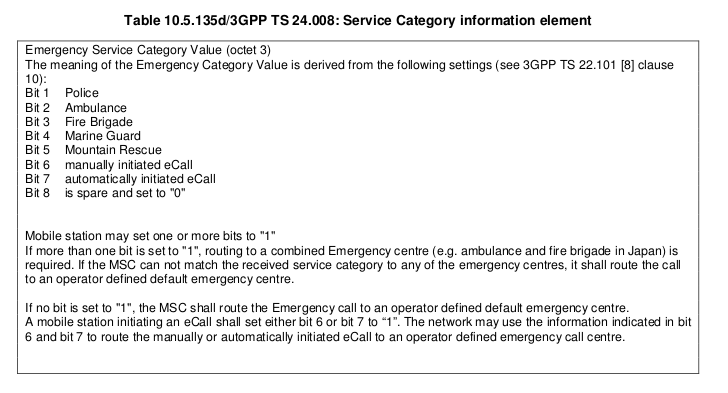Once upon a time, emergency calls were a simple thing in GSM networks. It was agreed that 112 and 911 would be universal emergency call numbers anywhere. When the user dials those numbers an Emergency Call Setup is made without the dialed number. The call is then given priority by the network and is routed to the next emergency response center. But that was back in 1991. In the meantime a number of additional sources of emergency call numbers and additional functionality has been added to the 3GPP standards. One addition was to store additional emergency call numbers on the SIM card which would also trigger an emergency call setup. And probably again a bit later another addition was standardized that lets the network inform devices about additional numbers.
A lot of stuff is standardized but never used in real networks so I don’t bother writing about them. Recently, I saw the network provided emergency call numbers being used in practice and even though this is still an exception I put together some notes.
 As noted above, 112 and 911 are general emergency numbers that work in any case. In addition, the ECC field on the SIM card can hold several 6 digit numbers, a service name and, take note, an emergency service category for each to distinguish between different services such as police, fire brigade, medical emergency, etc. (see screenshot on the left). When an emergency call is established (without the dialed number) the service category can be included in the emergency setup message to allow the network to select a particular emergency response center. If the service category is not included, i.e. no additional emergency numbers are specified, the call is routed to a default emergency call center.
As noted above, 112 and 911 are general emergency numbers that work in any case. In addition, the ECC field on the SIM card can hold several 6 digit numbers, a service name and, take note, an emergency service category for each to distinguish between different services such as police, fire brigade, medical emergency, etc. (see screenshot on the left). When an emergency call is established (without the dialed number) the service category can be included in the emergency setup message to allow the network to select a particular emergency response center. If the service category is not included, i.e. no additional emergency numbers are specified, the call is routed to a default emergency call center.
The ‘network provided emergency numbers’ feature works in exactly the same way and puts the information in the GSM, UMTS and LTE Location Update, Routing Area Update and Tracking Area Update Accept messages. Not included is the human readable service name for each entry. For details see for example 24.008, 10.5.3.13. You might wonder why I’ve included a good old GSM specification document rather than an LTE reference. Well, you can look at the LTE NAS spec 24.301, 9.9.3.37 but it just points right back to 24.008. Unlike the SIM based alternative, these additional numbers are temporary and don’t survive a reboot. Also, the device has to delete them when it registers to a network in a different country (24.008, 4.4.4.6).
So what’s the advantage of the network based method compared to the SIM card approach? From my point of view the main advantage is that it is not necessary to update all SIM cards that are in use when a country decides to split a generic emergency call center into several, e.g. for police, fire department, etc. The second advantage I can imagine is that roamers also benefit from being able to dial the emergency call numbers while being in another country. Most roamers in my opinion, however, won’t care and won’t know the local emergency number and just dial what they are used to at home. This will work perfectly fine as the number itself is not part of the emergency call.
It is unfortunate that nations or operators injected Emergency Service Categories. Citizens are frequently confused when seeking emergency services and adding choices can hamper the process of calling for help. The simple and effective 112/911 mechanism brings the call to a center trained to evaluate the request and summon the best response from one or more agencies.
In the US we worked hard to combine all calls to single centers. Going backwards and forcing citizens to call different agencies is inconceivable.